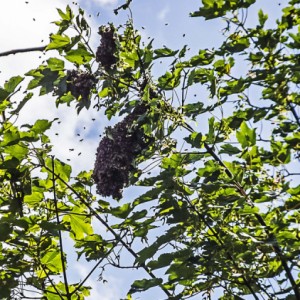#2 Doing the Practical.
Exam day and both my tyros did well, passing the Basic Beemaster exam with distinction; but before their heads get too big, it should be pointed out the we expect nothing less from our students. This year, we have eighteen being tested and I don’t expect any of them to achieve anything else. I was particularly pleased to hear that our two primary school kids did well as did the teenager; while their exam was somewhat easier than the adults’ version, the examiner likes to take things one step further - having covered the syllabus he then digs deeper to find out just how much his victims know and this showed how well our youngsters have come on in just one year of study.
The blip is of my second protégé (with his back to us, hereinafter known as #2) answering questions at the metaphorical coal-face. As they came away to do the theoretical assessment, we were told that the colony they had been using for the practical had no queen, but plenty of queen cells, both sealed and unsealed. If you have been following my postings over the past few weeks, you will realise that this means that, not only has it recently swarmed, but some one has not been on the ball. Indeed, a swarm was found a few days ago, high up in a tree and rather close to overhead three phase power lines. No one tried to catch it.
A few minutes after #2 had been told of his success, the colony swarmed again. When this happens, there are quite a few bees in the air while they slowly emerge from the hive and settle on an allegedly suitable roost. When they have decided on their new home, they all take off at once; now that really is spectacular, the sky turns black with up to 30,000 bees milling around in a very small patch of sky. It is often said that bees in a swarm are not agressive; one of this little lot became tangled in my hair and I had to comb it out, another went into my mouth and was spat out. Neither of them stung me.
The first extra is the bees in the air just beginning to settle, you can see a few small clusters of them on the sycamore leaves at the very top of the tree about 40 foot off the ground, while the second is the cluster just about complete although there are a couple of small outlying groups. The weight of the bees combined with the blustery wind at that height is causing the slender stem on which they have settled to sway quite violently with a total sideways movement of about six feet. The natural position of that stem is vertical (as can be seen in the first picture) while one expects the cluster to hang vertically and not at an angle of 45 degrees. It’s amazing that they weren’t blown off while I was there - though perhaps they were later.



Comments
Sign in or get an account to comment.


